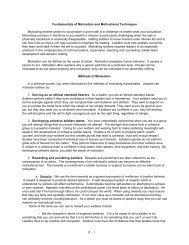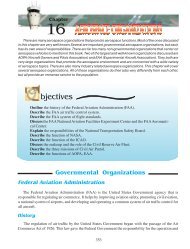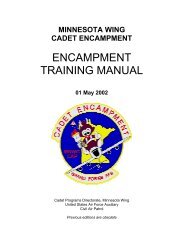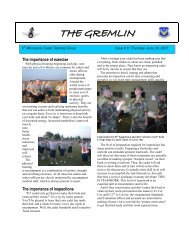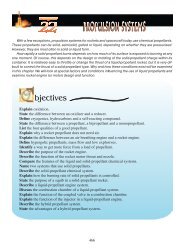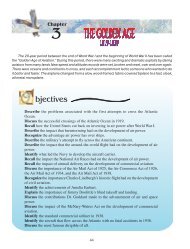Layout 1 - Civil Air Patrol
Layout 1 - Civil Air Patrol
Layout 1 - Civil Air Patrol
Create successful ePaper yourself
Turn your PDF publications into a flip-book with our unique Google optimized e-Paper software.
07-Chapter 9 Reboot Attempt pp 13-end_<strong>Layout</strong> 1 5/4/12 12:42 Page 37<br />
Latent Conflict is that which should be occurring, but is not. Do you<br />
like dealing with conflict Lots of people don’t. In fact, many of us<br />
avoid conflict if at all possible. Latent conflicts may go away on their<br />
own, continue for years, or eventually explode. Suppose a new, energetic<br />
senior member has not quite learned how to relate to the cadet<br />
staff. He monopolizes classroom discussions and interrupts you<br />
when you are training junior-ranking cadets. You hate this. But confronting<br />
an authority figure is so unpleasant, you decide to suffer in<br />
silence. In turn, the senior member’s domineering style continues<br />
for weeks. The conflict is real, but you are keeping it under wraps.<br />
The conflict is latent.<br />
False Conflict is the tragic case of disagreements that have no basis in<br />
reality. Surely you’ve been mad about something, only to find out<br />
that your anger was not justified. Misunderstandings produce false<br />
conflicts. Suppose an officer were to advocate that cadet training<br />
include anti-bullying, equal opportunity, and anti-discrimination<br />
topics. Another leader objects, insisting that cadets be trained in<br />
Core Values. Although they do not realize it, both parties want the<br />
same thing. Their use of jargon is causing confusion. After all, the<br />
Core Value of “Respect” suggests that bullying, discrimination, and<br />
the like are simply not tolerated. In truth, there is no disagreement<br />
here. This is a false conflict.<br />
Suffering in Silence<br />
Conflict can be so unpleasant<br />
that many of us will avoid it at all<br />
costs. When a conflict should be<br />
occurring but is not, the situation<br />
is said to exhibit latent conflict.<br />
LESSON FOR CADET OFFICERS<br />
Some conflicts reflect real problems, while others reflect perceived<br />
problems. Sometimes one party is misguided, sometimes both. Because<br />
there is no single type of conflict, there is no single approach<br />
or solution to conflict. The successful leader must be adaptable and<br />
carry a mixed bag of tools for resolving conflict.<br />
A MODEL OF INTERPERSONAL CONFLICT<br />
OBJECTIVES:<br />
35. Describe what occurs during each of the five phases of the model<br />
of interpersonal conflict.<br />
36. Describe some of the key points for managing conflict effectively.<br />
What’s really going on inside an interpersonal conflict If we try to<br />
look at interpersonal conflict scientifically, what do we observe So<br />
far we’ve discussed the important role leaders play in resolving conflict,<br />
and five different types of conflict. Next we’ll consider a model<br />
that explains the contexts, interactions, and outcomes that are found<br />
in interpersonal conflict. 111<br />
This section studies the<br />
anatomy of conflicts.<br />
For tips on mediating<br />
conflict, see chapter 6.<br />
37<br />
Distal (Background) Context. There’s always a context to a conflict, a<br />
setting or a history that shapes the conflict from the beginning. The



